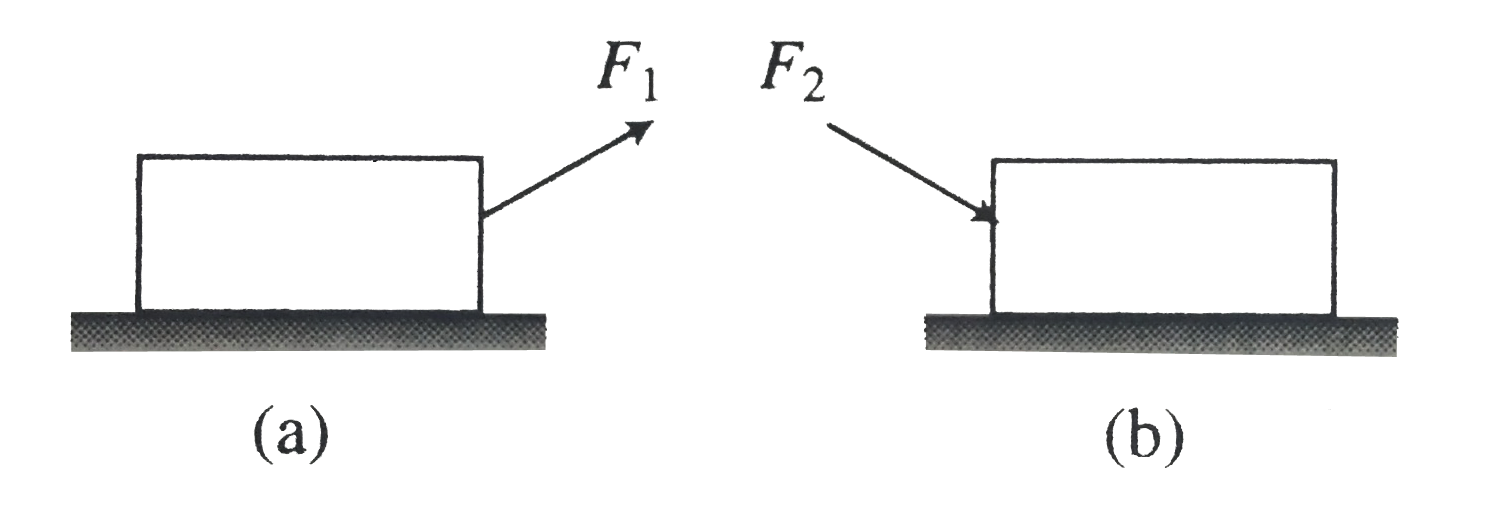Each question contains Statement I and Statement II. Of these Statements, mark correct choice if
Statement I: It is easier to pull a heavy object than to push it on a level ground.
Statement II: The magnitude of frictional force depends on the nature of the two surfaces in contact.
Statements I and II are true and Statement II is a correct explanation for Statement I.
Statements I and II are true and Statement II is not a correct explanation for Statement I.
Statement I is true, Statement II is false
Statement I is false, Statement II is true.
The correct Answer is:B
Statement II is not the correct explanation of Statement I. Statement I is true. The correct explanation of Statement I is there is an increase in the normal reaction when the object is pushed and there is decrease in the normal reaction when object is pulled.
Similar Questions
STATEMENT-1: It is easier to pull a heavy object than to push it on a level ground and
STATEMENT-2: The magnitude of frictional force depends on the nature of the two surfaces in contact.
View SolutionSTATEMENT-1: It is easier to pull a heavy object than to push it on a level ground and
STATEMENT-2: The magnitude fo frictional force depends on the nature of the two surfaces in contact.
View Solution
Knowledge Check
STATEMENT-1: It is easier to pull a heavy object than to push it on a level ground and
STATEMENT-2: The magnitude of frictional force depends on the nature of the two surfaces in contact.A(a) Statement-1 is True, Statement-2 is True, Statement-2 is a correct explanation for Statement-1B(b) Statement-1 is True, Statement-2 is True, Statement-2 is NOT a correct explaination for Statement-1C(c) Statement-1 is True, Statement-2 is FalseD(d) Statement-1 is False, Statement-2 is True.Statement I: Pulling is easier than pushing on a rough surface.

Statement II: Normal reaction is less in pulling than in pushing.AStatement I is true, statement II is true, Statement II is the correct explanation for statement I.BStatemet I is true, Statement II is true , Statement II is NOT the correct explanation for Statement ICStatement I is True, Statement II is False.DStatement I is False, Statement II is trueThe magnitude of frictional force depends on
(I) The surface area of contact.
(II) The weight of the object.
(III) The condition of the surface in contact.AI and II onlyBII and III onlyCIII and I onlyDAll of these
Statement I: Pulling is easier than pushing on a rough surface.

Statement II: Normal reaction is less in pulling than in pushing.
View SolutionSome questions (Assertion-Reason Type) are given below. Each question contains Statement I (Assertion) and statement II(reason). Each question has 4 choices (a),(b),(c ) and (d) out of which only one is correct. So select the correct choise.
a. Statement I is True, Statement II is True,Statement II is a correct explanation for Statement I
b. Statement I is True, Statement II is True, Statement II is NOT a correct ecplanation for Statement I
c. Statement I is True, Statement II is False .
d. Statement I is false, Statement II is True.
3. Statement I: The de Broglie wavelength of a molecule (in a sample of ideal gas) varies inversely as the square root of absolute temperature.
Statement II: The de Broglie wavelength of a molecule (in sample of ideal gas) depends on temperature.
View SolutionSome questions (Assertion-Reason Type) are given below. Each question contains Statement I (Assertion) and statement II(reason). Each question has 4 choices (a),(b),(c ) and (d) out of which only one is correct. So select the correct choise.
a. Statement I is True, Statement II is True,Statement II is a correct explanation for Statement I
b. Statement I is True, Statement II is True, Statement II is NOT a correct ecplanation for Statement I
c. Statement I is True, Statement II is False .
d. Statement I is false, Statement II is True.
1. A proton and an electron both have energy 50 eV.
Statement I: Both have different wavelength.
Statement II: Wavelength depends on energy and not on mass.
View SolutionSome questions (Assertion-Reason Type) are given below. Each question contains Statement I (Assertion) and statement II(reason). Each question has 4 choices (a),(b),(c ) and (d) out of which only one is correct. So select the correct choise.
a. Statement I is True, Statement II is True,Statement II is a correct explanation for Statement I
b. Statement I is True, Statement II is True, Statement II is NOT a correct ecplanation for Statement I
c. Statement I is True, Statement II is False .
d. Statement I is false, Statement II is True.
Statement:I Though light of a single frequency (monochromatic light) is incident on a metal, the energies of emitted photoelectrons are different.
Statement II: The energy of electrons just after they absorb photons incident on the metal surface may be lost in collision with other atoms in the metal before the electron is ejected out of the metal.
View SolutionSome questions (Assertion-Reason Type) are given below. Each question contains Statement I (Assertion) and statement II(reason). Each question has 4 choices (a),(b),(c ) and (d) out of which only one is correct. So select the correct choise.
a. Statement I is True, Statement II is True,Statement II is a correct explanation for Statement I
b. Statement I is True, Statement II is True, Statement II is NOT a correct ecplanation for Statement I
c. Statement I is True, Statement II is False .
d. Statement I is false, Statement II is True.
2. Statement:I Though light of a single frequency (monochromatic light) is incident on a metal, the energies of emitted photoelectrons are different.
Statement II: The energy of electrons just after they absorb photons incident on the metal surface may be lost in collision with other atoms in the metal before the electron is ejected out of the metal.
View Solution
